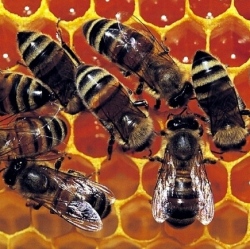
A tracker designed to monitor bees is being tested by ecologists at Kew Gardens in London. It is made from off-the-shelf technology and is based on equipment used to track pallets in warehouses, said its creator Dr Mark O’Neill. Readers, used to pick up a signal from the kit, are connected to Raspberry Pi computers.
The tracker consists of a standard RFID (radio frequency identification) chip and a specially designed aerial, which Dr O’Neill has created to be thinner and lighter than other models used to track small insects, allowing him to boost the range.
The engineer, who is technical director at the Newcastle-based tech firm Tumbling Dice, is currently trying to patent the invention. "The first stage was to make very raw pre-production tags using components I could easily buy", he said.
"I want to make optimised aerial components which would be a lot smaller. I’ve made about 50 so far. I’ve soldered them all on my desk – it feels like surgery." The average "forage time" for a worker bee is around 20 minutes, suggesting they have a forage range of around 1km (0.6 miles) , Dr O’Neill explained.
The idea is to have readers dotted around a hive and flower patch in order to track the signals as the bees move around freely in the wild.
